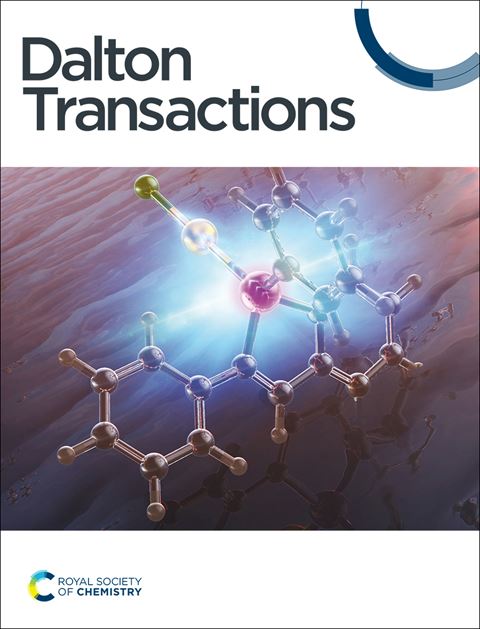基于分层镧系元素的自组装复合物在竞争介质中对温度变化和化学反应都有可逆的发光响应
IF 3.5
3区 化学
Q2 CHEMISTRY, INORGANIC & NUCLEAR
引用次数: 0
摘要
本文报道了Eu3+-1-DPA发光配合物在水-有机(THF或乙醇)混合溶液中的分层自组装形成,并研究了其对温度变化和原位化学反应的可逆响应行为。合成了配体1-DPA、1-DPA-乙酸酯以及1-DPA、Eu3+-1-DPA的Eu(III)配合物,并测定了它们的x射线晶体结构。在有机水(THF或乙醇)混合溶液中,研究了1-DPA和1-DPA-乙酸酯原位形成的配体和Eu(III)配合物的光物理和材料(形态)性质。通过对这些配合物在乙醇-水混合物中的滴铸溶液进行扫描电镜成像,可以发现配体和配合物聚集成分层且均匀形成的微球和微棒。Eu3+-1-DPA配合物产生Eu(III)中心发射[由于5D0 - 7FJ (J = 1-4)失活],这显示出可逆的,热响应的镧系元素中心发射,而使用酸性酸酐的原位酯化(形成Eu3+-1-DPA-醋酸酯,不发射),随后NaOH介导的Eu3+-1-DPA-醋酸酯组装体的水解诱导Eu(III)发射和形貌变化,通过光谱和扫描电镜成像研究证实。本文章由计算机程序翻译,如有差异,请以英文原文为准。
Hierarchical lanthanide based self-assembly complexes that undergo reversible luminescent response to both temperature changes and chemical reactions within competitive media
Here we report hierarchical self-assembly formation of luminescent Eu3+-1-DPA complex in mixed aqueous-organic (THF or ethanol) solutions and its reversible responsive behaviour to temperature change and in situ chemical reactions were investigated. The ligands 1-DPA and 1-DPA-acetate as well as the Eu(III) complex of 1-DPA, Eu3+-1-DPA were synthesised, as well as their X-ray crystal structures were determined. The photophysical and material (morphological) properties of the ligands and the Eu(III) complexes formed in situ of both 1-DPA and 1-DPA-acetate were probed in mixed aqueous-organic (THF or ethanol) solutions. The ligands as well as the complexes were shown to aggregate into hierarchical and homogenously formed microspheres and microrods, as demonstrated by carrying out SEM imaging of the drop cast solutions of these complexes in ethanol-water mixtures. The Eu3+-1-DPA complex gave rise to Eu(III) centred emission [due to deactivation of the 5D0 7FJ (J = 1-4)], which showed reversible, thermo-responsive lanthanide centred emission, while in situ esterification using acidic anhydride (forming Eu3+-1-DPA-acetate, which was not emissive), and subsequent NaOH mediated hydrolysis of the Eu3+-1-DPA-acetate assembly induced both Eu(III)-emission and morphology changes as demonstrated using both spectroscopic and SEM imaging studies.
求助全文
通过发布文献求助,成功后即可免费获取论文全文。
去求助
来源期刊

Dalton Transactions
化学-无机化学与核化学
CiteScore
6.60
自引率
7.50%
发文量
1832
审稿时长
1.5 months
期刊介绍:
Dalton Transactions is a journal for all areas of inorganic chemistry, which encompasses the organometallic, bioinorganic and materials chemistry of the elements, with applications including synthesis, catalysis, energy conversion/storage, electrical devices and medicine. Dalton Transactions welcomes high-quality, original submissions in all of these areas and more, where the advancement of knowledge in inorganic chemistry is significant.
 求助内容:
求助内容: 应助结果提醒方式:
应助结果提醒方式:


